Fibrous Microplastics Release from Textile Production Phases: A Brief Review of Current Challenges and Applied Research Directions
Abstract
1. Introduction
2. Microplastic Shedding from the Textile Production Process
2.1. Factors Influencing Microplastic Shedding During Textile Dry Processes
| Conditions | Composition/Type of Fabric | Size and/or Amount | Reference |
|---|---|---|---|
| Outdoor—environment | - | 2–100 µm; ~1 MPs/m3 | [44] |
| Outdoor—environment | PET, PS, PE, PVC, PET | 25–2600 µm; 365 ± 69 MPs/day/m2 | [37] |
| Indoor—closed condition | PET-woven-filament | 1 ± 1 MPs/g of fabric | [38] |
| PET-knit-filament | 108 ± 44 MPs/g of fabric | ||
| PET-Knit-staple | 347 ±102 MPs/g of fabric | ||
| PET/COT-knit staple | 403 ± 65 MPs/g of fabric | ||
| Outdoor—dryer exhaust | Polyester | 93 ± 17 MPs/g of fabric; 15 min of drying | [45] |
| Cotton | 72 ± 11 MPs/g of fabric; 15 min of drying | ||
| Indoor—closed condition | Polyester | 1.6 ± 1.8 MPs/m3 | [46] |
2.2. Factors Influencing Microplastic Shedding During Textile Wet Processes
3. Microplastics in the Industrial Wastewater Treatment Plant
4. Recycling, Upcycling Technologies, and Future Directions
5. Conclusions
Author Contributions
Funding
Institutional Review Board Statement
Informed Consent Statement
Data Availability Statement
Conflicts of Interest
References
- Gago, J.; Carretero, O.; Filgueiras, A.V.; Viñas, L. Synthetic Microfibers in the Marine Environment: A Review on Their Occurrence in Seawater and Sediments. Mar. Pollut. Bull. 2018, 127, 365–376. [Google Scholar] [CrossRef]
- Perkins, D.M.; Müller, H.L.; Grünewald, S.; Reiss, J.; Restrepo-Sulez, K.; Robertson, A.; Perna, A. Microplastic Ingestion by an Aquatic Ciliate: Functional Response, Modulation, and Reduced Population Growth. Sci. Total Environ. 2025, 963, 178272. [Google Scholar] [CrossRef] [PubMed]
- Rech, S.; Macaya-Caquilpán, V.; Pantoja, J.F.; Rivadeneira, M.M.; Jofre Madariaga, D.; Thiel, M. Rivers as a Source of Marine Litter—A Study from the SE Pacific. Mar. Pollut. Bull. 2014, 82, 66–75. [Google Scholar] [CrossRef] [PubMed]
- Obbard, R.W.; Sadri, S.; Wong, Y.Q.; Khitun, A.A.; Baker, I.; Thompson, R.C. Global Warming Releases Microplastic Legacy Frozen in Arctic Sea Ice. Earths Future 2014, 2, 315–320. [Google Scholar] [CrossRef]
- Ullah, Z.; Peng, L.; Lodhi, A.F.; Kakar, M.U.; Mehboob, M.Z.; Iqbal, I. The Threat of Microplastics and Microbial Degradation Potential; a Current Perspective. Sci. Total Environ. 2024, 955, 177045. [Google Scholar] [CrossRef]
- Gao, J.; Ju, Z.; Yang, Q.; Zhou, X. Exploring Different Effects of Biofilm Formation and Natural Organic Matter Adsorption on the Properties of Three Typical Microplastics in the Freshwater. Sci. Total Environ. 2025, 958, 178156. [Google Scholar] [CrossRef]
- Jin, T.; Tang, J.; Lyu, H.; Wang, L.; Gillmore, A.B.; Schaeffer, S.M. Activities of Microplastics (MPs) in Agricultural Soil: A Review of MPs Pollution from the Perspective of Agricultural Ecosystems. J. Agric. Food Chem. 2022, 70, 4182–4201. [Google Scholar] [CrossRef]
- Zambrano, M.C.; Pawlak, J.J.; Daystar, J.; Ankeny, M.; Venditti, R.A. Impact of Dyes and Finishes on the Microfibers Released on the Laundering of Cotton Knitted Fabrics. Environ. Pollut. 2021, 272, 115998. [Google Scholar] [CrossRef]
- Liu, J.; Liang, J.; Ding, J.; Zhang, G.; Zeng, X.; Yang, Q.; Zhu, B.; Gao, W. Microfiber Pollution: An Ongoing Major Environmental Issue Related to the Sustainable Development of Textile and Clothing Industry. Environ. Dev. Sustain. 2021, 23, 11240–11256. [Google Scholar] [CrossRef]
- Yasin, S.; Hussain, M.; Uddin, A.; Zheng, Q.; Shi, J.; Song, Y. Recycling of binary polymer (PET/SBR) carpet into microfibrillar composites: A life cycle perspective with microplastics quantification. Sustain. Mater. Technol. 2024, 40, e00988. [Google Scholar] [CrossRef]
- Pensupa, N.; Leu, S.-Y.; Hu, Y.; Du, C.; Liu, H.; Jing, H.; Wang, H.; Lin, C.S.K. Recent Trends in Sustainable Textile Waste Recycling Methods: Current Situation and Future Prospects. Top Curr. Chem. 2017, 375, 76. [Google Scholar] [CrossRef]
- Militký, J.; Křemenáková, D.; Venkataraman, M.; Aneja, A.P. Towards Sustainable Textiles for a Safer Planet: Main Topics. Sustainability 2024, 16, 5344. [Google Scholar] [CrossRef]
- Wang, M.; Yang, J.; Zheng, S.; Jia, L.; Yong, Z.Y.; Yong, E.L.; See, H.H.; Li, J.; Lv, Y.; Fei, X.; et al. Unveiling the Microfiber Release Footprint: Guiding Control Strategies in the Textile Production Industry. Environ. Sci. Technol. 2023, 57, 21038–21049. [Google Scholar] [CrossRef]
- Cai, Y.; Mitrano, D.M.; Heuberger, M.; Hufenus, R.; Nowack, B. The Origin of Microplastic Fiber in Polyester Textiles: The Textile Production Process Matters. J. Clean. Prod. 2020, 267, 121970. [Google Scholar] [CrossRef]
- Zhang, Y.; Haque, A.N.M.A.; Ranjbar, S.; Tester, D.; Naebe, M. A Standard Terminology for the Description of Fibrous Microplastics from Textiles. Adv. Sci. Technol. 2024, 146, 33–36. [Google Scholar] [CrossRef]
- Thompson, R.C.; Courtene-Jones, W.; Boucher, J.; Pahl, S.; Raubenheimer, K.; Koelmans, A.A. Twenty Years of Microplastic Pollution Research—What Have We Learned? Science 2024, 386, eadl2746. [Google Scholar] [CrossRef]
- Zhang, Y.-Q.; Lykaki, M.; Alrajoula, M.T.; Markiewicz, M.; Kraas, C.; Kolbe, S.; Klinkhammer, K.; Rabe, M.; Klauer, R.; Bendt, E.; et al. Microplastics from Textile Origin—Emission and Reduction Measures. Green Chem. 2021, 23, 5247–5271. [Google Scholar] [CrossRef]
- Acharya, S.; Rumi, S.S.; Hu, Y.; Abidi, N. Microfibers from Synthetic Textiles as a Major Source of Microplastics in the Environment: A Review. Text. Res. J. 2021, 91, 2136–2156. [Google Scholar] [CrossRef]
- Gliaudelytė, U.; Persson, M.; Daukantienė, V. Impact of Textile Composition, Structure, and Treatment on Microplastic Release during Washing: A Review. Text. Res. J. 2024, 95, 00405175241260066. [Google Scholar] [CrossRef]
- Rathinamoorthy, R.; Raja Balasaraswathi, S. Impact of Sewing on Microfiber Release from Polyester Fabric during Laundry. Sci. Total Environ. 2023, 903, 166247. [Google Scholar] [CrossRef]
- Belzagui, F.; Crespi, M.; Álvarez, A.; Gutiérrez-Bouzán, C.; Vilaseca, M. Microplastics’ Emissions: Microfibers’ Detachment from Textile Garments. Environ. Pollut. 2019, 248, 1028–1035. [Google Scholar] [CrossRef] [PubMed]
- Özkan, İ.; Gündoğdu, S. Investigation on the Microfiber Release under Controlled Washings from the Knitted Fabrics Produced by Recycled and Virgin Polyester Yarns. J. Text. Inst. 2021, 112, 264–272. [Google Scholar] [CrossRef]
- Allen, E.; Henninger, C.E.; Garforth, A.; Asuquo, E. Microfiber Pollution: A Systematic Literature Review to Overcome the Complexities in Knit Design to Create Solutions for Knit Fabrics. Environ. Sci. Technol. 2024, 58, 4031–4045. [Google Scholar] [CrossRef] [PubMed]
- Rathinamoorthy, R.; Raja Balasaraswathi, S. Microfiber Pollution Prevention—Mitigation Strategies and Challenges. In Microfiber Pollution; Rathinamoorthy, R., Raja Balasaraswathi, S., Eds.; Springer Nature: Singapore, 2022; pp. 205–243. ISBN 978-981-19-4185-6. [Google Scholar]
- Palacios-Mateo, C.; van der Meer, Y.; Seide, G. Analysis of the Polyester Clothing Value Chain to Identify Key Intervention Points for Sustainability. Environ. Sci. Eur. 2021, 33, 2. [Google Scholar] [CrossRef]
- Rosa, R.P.; Rosace, G.; Trovato, V. Recent Advancements in Acrylic Fabric Applications: A Comprehensive Review and Future Trends. Polymers 2024, 16, 2111. [Google Scholar] [CrossRef]
- Pinlova, B.; Hufenus, R.; Nowack, B. Systematic Study of the Presence of Microplastic Fibers during Polyester Yarn Production. J. Clean. Prod. 2022, 363, 132247. [Google Scholar] [CrossRef]
- Jabbar, A.; Tausif, M. Investigation of Ring, Airjet and Rotor Spun Yarn Structures on the Fragmented Fibers (Microplastics) Released from Polyester Textiles during Laundering. Text. Res. J. 2023, 93, 5017–5028. [Google Scholar] [CrossRef]
- Palacios-Marín, A.V.; Jabbar, A.; Tausif, M. Fragmented Fiber Pollution from Common Textile Materials and Structures during Laundry. Text. Res. J. 2022, 92, 2265–2275. [Google Scholar] [CrossRef]
- Hazlehurst, A.; Sumner, M.; Taylor, M. Investigating the Influence of Yarn Characteristics on Microfibre Release from Knitted Fabrics during Laundering. Front Environ. Sci. 2024, 12, 1340229. [Google Scholar] [CrossRef]
- Sillanpää, M.; Sainio, P. Release of Polyester and Cotton Fibers from Textiles in Machine Washings. Environ. Sci. Pollut. Res. 2017, 24, 19313–19321. [Google Scholar] [CrossRef]
- Xiao, S.; Cui, Y.; Brahney, J.; Mahowald, N.M.; Li, Q. Long-distance atmospheric transport of microplastic fibres influenced by their shapes. Nat. Geosci. 2023, 16, 863–870. [Google Scholar] [CrossRef]
- Klein, M.; Fischer, E.K. Microplastic abundance in atmospheric deposition within the Metropolitan area of Hamburg, Germany. Sci. Total Environ. 2019, 685, 96–103. [Google Scholar] [CrossRef]
- Dris, R.; Gasperi, J.; Rocher, V.; Saad, M.; Renault, N.; Tassin, B. Microplastic Contamination in an Urban Area: A Case Study in Greater Paris. Environ. Chem. 2015, 12, 592. [Google Scholar] [CrossRef]
- Schwabl, P.; Köppel, S.; Königshofer, P.; Bucsics, T.; Trauner, M.; Reiberger, T.; Liebmann, B. Detection of Various Microplastics in Human Stool. Ann. Intern. Med. 2019, 171, 453–457. [Google Scholar] [CrossRef] [PubMed]
- Goodman, K.E.; Hare, J.T.; Khamis, Z.I.; Hua, T.; Sang, Q.-X.A. Exposure of Human Lung Cells to Polystyrene Microplastics Significantly Retards Cell Proliferation and Triggers Morphological Changes. Chem. Res. Toxicol. 2021, 34, 1069–1081. [Google Scholar] [CrossRef]
- Allen, S.; Allen, D.; Phoenix, V.R.; Le Roux, G.; Durántez Jiménez, P.; Simonneau, A.; Binet, S.; Galop, D. Atmospheric Transport and Deposition of Microplastics in a Remote Mountain Catchment. Nat. Geosci. 2019, 12, 339–344. [Google Scholar] [CrossRef]
- De Falco, F.; Cocca, M.; Avella, M.; Thompson, R.C. Microfiber Release to Water, Via Laundering, and to Air, via Everyday Use: A Comparison between Polyester Clothing with Differing Textile Parameters. Environ. Sci. Technol. 2020, 54, 3288–3296. [Google Scholar] [CrossRef]
- Prata, J.C. Airborne Microplastics: Consequences to Human Health? Environ. Pollut. 2018, 234, 115–126. [Google Scholar] [CrossRef]
- Wright, S.L.; Kelly, F.J. Plastic and Human Health: A Micro Issue? Environ. Sci. Technol. 2017, 51, 6634–6647. [Google Scholar] [CrossRef]
- Gasperi, J.; Wright, S.L.; Dris, R.; Collard, F.; Mandin, C.; Guerrouache, M.; Langlois, V.; Kelly, F.J.; Tassin, B. Microplastics in Air: Are We Breathing It In? Curr. Opin. Environ. Sci. Health 2018, 1, 1–5. [Google Scholar] [CrossRef]
- Campanale, C.; Massarelli, C.; Savino, I.; Locaputo, V.; Uricchio, V.F. A Detailed Review Study on Potential Effects of Microplastics and Additives of Concern on Human Health. Int. J. Environ. Res. Public Health 2020, 17, 1212. [Google Scholar] [CrossRef] [PubMed]
- Ragusa, A.; Svelato, A.; Santacroce, C.; Catalano, P.; Notarstefano, V.; Carnevali, O.; Papa, F.; Rongioletti, M.C.A.; Baiocco, F.; Draghi, S.; et al. Plasticenta: First Evidence of Microplastics in Human Placenta. Environ. Int. 2021, 146, 106274. [Google Scholar] [CrossRef] [PubMed]
- Abbasi, S.; Keshavarzi, B.; Moore, F.; Turner, A.; Kelly, F.J.; Dominguez, A.O.; Jaafarzadeh, N. Distribution and Potential Health Impacts of Microplastics and Microrubbers in Air and Street Dusts from Asaluyeh County, Iran. Environ. Pollut. 2019, 244, 153–164. [Google Scholar] [CrossRef] [PubMed]
- Tao, D.; Zhang, K.; Xu, S.; Lin, H.; Liu, Y.; Kang, J.; Yim, T.; Giesy, J.P.; Leung, K.M.Y. Microfibers Released into the Air from a Household Tumble Dryer. Environ. Sci. Technol. Lett. 2022, 9, 120–126. [Google Scholar] [CrossRef]
- O’Brien, S.; Okoffo, E.D.; O’Brien, J.W.; Ribeiro, F.; Wang, X.; Wright, S.L.; Samanipour, S.; Rauert, C.; Toapanta, T.Y.A.; Albarracin, R.; et al. Airborne Emissions of Microplastic Fibres from Domestic Laundry Dryers. Sci. Total Environ. 2020, 747, 141175. [Google Scholar] [CrossRef]
- Dalla Fontana, G.; Mossotti, R.; Montarsolo, A. Assessment of Microplastics Release from Polyester Fabrics: The Impact of Different Washing Conditions. Environ. Pollut. 2020, 264, 113960. [Google Scholar] [CrossRef]
- Cesa, F.S.; Turra, A.; Checon, H.H.; Leonardi, B.; Baruque-Ramos, J. Laundering and Textile Parameters Influence Fibers Release in Household Washings. Environ. Pollut. 2020, 257, 113553. [Google Scholar] [CrossRef]
- Broadbent, A.D. Basic Principles of Textile Coloration; Society of Dyers and Colorists: Bradford, UK, 2001; Volume 132, ISBN 9780901956767. [Google Scholar]
- Chakraborty, J.N. Fundamentals and Practices in Colouration of Textiles; Chakraborty, J.N., Chakraborty, J.N., Eds.; WPI Publishing: Worcester, MA, USA, 2015; ISBN 9780429155574. [Google Scholar]
- De Falco, F.; Gullo, M.P.; Gentile, G.; Di Pace, E.; Cocca, M.; Gelabert, L.; Brouta-Agnésa, M.; Rovira, A.; Escudero, R.; Villalba, R.; et al. Evaluation of Microplastic Release Caused by Textile Washing Processes of Synthetic Fabrics. Environ. Pollut. 2018, 236, 916–925. [Google Scholar] [CrossRef]
- Chan, C.K.-M.; Fang, J.K.-H.; Fei, B.; Kan, C.-W. Microfibres Release from Textile Industry Wastewater Effluents Are Underestimated: Mitigation Actions That Need to Be Prioritised. Fibers 2023, 11, 105. [Google Scholar] [CrossRef]
- Paz-Gómez, G.; del Caño-Ochoa, J.C.; Rodríguez-Alabanda, O.; Romero, P.E.; Cabrerizo-Vílchez, M.; Guerrero-Vaca, G.; Rodríguez-Valverde, M.A. Water-Repellent Fluoropolymer-Based Coatings. Coatings 2019, 9, 293. [Google Scholar] [CrossRef]
- Özer, M.S.; Gaan, S. Recent Developments in Phosphorus Based Flame Retardant Coatings for Textiles: Synthesis, Applications and Performance. Prog. Org. Coat. 2022, 171, 107027. [Google Scholar] [CrossRef]
- Naebe, M.; Haque, A.N.M.A.; Haji, A. Plasma-Assisted Antimicrobial Finishing of Textiles: A Review. Engineering 2022, 12, 145–163. [Google Scholar] [CrossRef]
- De Smet, D.; Uyttendaele, W.; Vanneste, M. Bio-Based 2K PU Coating for Durable Textile Applications. Coatings 2022, 12, 169. [Google Scholar] [CrossRef]
- Chruściel, J.J. Modifications of Textile Materials with Functional Silanes, Liquid Silicone Softeners, and Silicone Rubbers—A Review. Polymers 2022, 14, 4382. [Google Scholar] [CrossRef]
- Periolatto, M.; Ferrero, F.; Vineis, C.; Varesano, A.; Gozzelino, G. Novel Antimicrobial Agents and Processes for Textile Applications. In Antibacterial Agents; InTech: Houston, TX, USA, 2017. [Google Scholar]
- Coelho, E.C.; dos Santos, D.P.; Ciuffi, K.J.; Ferrari, J.L.; Ferreira, B.A.; Schiavon, M.A. Poly(Vinyl Alcohol) and Poly(Dimethylsiloxane)-Based Interpenetrating Polymer Networks via Radical Polymerisation. J. Polym. Res. 2014, 21, 561. [Google Scholar] [CrossRef]
- Vassilenko, E.; Watkins, M.; Chastain, S.; Mertens, J.; Posacka, A.M.; Patankar, S.; Ross, P.S. Domestic Laundry and Microfiber Pollution: Exploring Fiber Shedding from Consumer Apparel Textiles. PLoS ONE 2021, 16, e0250346. [Google Scholar] [CrossRef]
- Yaseen, D.A.; Scholz, M. Textile Dye Wastewater Characteristics and Constituents of Synthetic Effluents: A Critical Review. Int. J. Environ. Sci. Technol. 2019, 16, 1193–1226. [Google Scholar] [CrossRef]
- Bidu, J.M.; Van der Bruggen, B.; Rwiza, M.J.; Njau, K.N. Current Status of Textile Wastewater Management Practices and Effluent Characteristics in Tanzania. Water Sci. Technol. 2021, 83, 2363–2376. [Google Scholar] [CrossRef] [PubMed]
- Ramasamy, R.; Aragaw, T.A.; Balasaraswathi Subramanian, R. Wastewater Treatment Plant Effluent and Microfiber Pollution: Focus on Industry-Specific Wastewater. Environ. Sci. Pollut. Res. 2022, 29, 51211–51233. [Google Scholar] [CrossRef]
- Tang, N.; Liu, X.; Xing, W. Microplastics in Wastewater Treatment Plants of Wuhan, Central China: Abundance, Removal, and Potential Source in Household Wastewater. Sci. Total Environ. 2020, 745, 141026. [Google Scholar] [CrossRef]
- Lin, L.; Zuo, L.-Z.; Peng, J.-P.; Cai, L.-Q.; Fok, L.; Yan, Y.; Li, H.-X.; Xu, X.-R. Occurrence and Distribution of Microplastics in an Urban River: A Case Study in the Pearl River along Guangzhou City, China. Sci. Total Environ. 2018, 644, 375–381. [Google Scholar] [CrossRef] [PubMed]
- Carnevale, M.M.; Galafassi, S.; Zullo, R.; Torretta, V.; Rada, E.C. Microplastics removal in wastewater treatment plants: A review of the different approaches to limit their release in the environment. Sci. Total Environ. 2024, 930, 172675. [Google Scholar] [CrossRef]
- Magnusson, K.; Norén, F. Screening of Microplastic Particles in and Down-Stream a Wastewater Treatment Plant; Swedish Environmental Protection Agency: Stockholm, Sweden, 2014. [Google Scholar]
- Deng, H.; Wei, R.; Luo, W.; Hu, L.; Li, B.; Di, Y.; Shi, H. Microplastic Pollution in Water and Sediment in a Textile Industrial Area. Environ. Pollut. 2020, 258, 113658. [Google Scholar] [CrossRef] [PubMed]
- Xu, X.; Hou, Q.; Xue, Y.; Jian, Y.; Wang, L. Pollution Characteristics and Fate of Microfibers in the Wastewater from Textile Dyeing Wastewater Treatment Plant. Water Sci. Technol. 2018, 78, 2046–2054. [Google Scholar] [CrossRef]
- Xu, X.; Jian, Y.; Xue, Y.; Hou, Q.; Wang, L. Microplastics in the Wastewater Treatment Plants (WWTPs): Occurrence and Removal. Chemosphere 2019, 235, 1089–1096. [Google Scholar] [CrossRef]
- Wang, F.; Wang, B.; Duan, L.; Zhang, Y.; Zhou, Y.; Sui, Q.; Xu, D.; Qu, H.; Yu, G. Occurrence and Distribution of Microplastics in Domestic, Industrial, Agricultural and Aquacultural Wastewater Sources: A Case Study in Changzhou, China. Water Res. 2020, 182, 115956. [Google Scholar] [CrossRef]
- Zhou, H.; Zhou, L.; Ma, K. Microfiber from Textile Dyeing and Printing Wastewater of a Typical Industrial Park in China: Occurrence, Removal and Release. Sci. Total Environ. 2020, 739, 140329. [Google Scholar] [CrossRef]
- Chan, C.K.M.; Park, C.; Chan, K.M.; Mak, D.C.W.; Fang, J.K.H.; Mitrano, D.M. Microplastic Fibre Releases from Industrial Wastewater Effluent: A Textile Wet-Processing Mill in China. Environ. Chem. 2021, 18, 93–100. [Google Scholar] [CrossRef]
- Haque, A.N.M.A.; Naebe, M. Sustainable Biodegradable Denim Waste Composites for Potential Single-Use Packaging. Sci. Total Environ. 2022, 809, 152239. [Google Scholar] [CrossRef]
- Al Faruque, M.A.; Remadevi, R.; Razal, J.M.; Naebe, M. Impact of the Wet Spinning Parameters on the Alpaca-Based Polyacrylonitrile Composite Fibers: Morphology and Enhanced Mechanical Properties Study. J. Appl. Polym. Sci. 2020, 137, 49264. [Google Scholar] [CrossRef]
- Juanga-Labayen, J.P.; Labayen, I.V.; Yuan, Q. A Review on Textile Recycling Practices and Challenges. Textiles 2022, 2, 174–188. [Google Scholar] [CrossRef]
- Hole, G.; Hole, A.S. Recycling as the Way to Greener Production: A Mini Review. J. Clean. Prod. 2019, 212, 910–915. [Google Scholar] [CrossRef]
- Li, Y.; Yi, H.; Li, M.; Ge, M.; Yao, D. Synchronous Degradation and Decolorization of Colored Poly(Ethylene Terephthalate) Fabrics for the Synthesis of High Purity Terephthalic Acid. J. Clean. Prod. 2022, 366, 132985. [Google Scholar] [CrossRef]
- Sakthivel, S.; Senthil Kumar, S.; Melese, B.; Mekonnen, S.; Solomon, E.; Edae, A.; Abedom, F.; Gedilu, M. Development of Nonwoven Composites from Recycled Cotton/Polyester Apparel Waste Materials for Sound Absorbing and Insulating Properties. Appl. Acoust. 2021, 180, 108126. [Google Scholar] [CrossRef]
- Hou, W.; Ling, C.; Shi, S.; Yan, Z. Preparation and Characterization of Microcrystalline Cellulose from Waste Cotton Fabrics by Using Phosphotungstic Acid. Int. J. Biol. Macromol. 2019, 123, 363–368. [Google Scholar] [CrossRef]
- Shi, S.; Zhang, M.; Ling, C.; Hou, W.; Yan, Z. Extraction and Characterization of Microcrystalline Cellulose from Waste Cotton Fabrics via Hydrothermal Method. Waste Manag. 2018, 82, 139–146. [Google Scholar] [CrossRef]
- Haslinger, S.; Hummel, M.; Anghelescu-Hakala, A.; Määttänen, M.; Sixta, H. Upcycling of Cotton Polyester Blended Textile Waste to New Man-Made Cellulose Fibers. Waste Manag. 2019, 97, 88–96. [Google Scholar] [CrossRef] [PubMed]
- Liu, W.; Liu, S.; Liu, T.; Liu, T.; Zhang, J.; Liu, H. Eco-Friendly Post-Consumer Cotton Waste Recycling for Regenerated Cellulose Fibers. Carbohydr. Polym. 2019, 206, 141–148. [Google Scholar] [CrossRef]
- Islam, S.; El Messiry, M.; Sikdar, P.P.; Seylar, J.; Bhat, G. Microstructure and Performance Characteristics of Acoustic Insulation Materials from Post-Consumer Recycled Denim Fabrics. J. Ind. Text. 2020, 51, 6001S–6027S. [Google Scholar] [CrossRef]
- Weis, J.S.; De Falco, F. Microfibers: Environmental Problems and Textile Solutions. Microplastics 2022, 1, 626–639. [Google Scholar] [CrossRef]
- Abbate, S.; Centobelli, P.; Cerchione, R.; Nadeem, S.P.; Riccio, E. Sustainability Trends and Gaps in the Textile, Apparel and Fashion Industries. Environ. Dev. Sustain. 2024, 26, 2837–2864. [Google Scholar] [CrossRef] [PubMed]
- Yang, T.; Nowack, B. Formation of nanoparticles during accelerated UV degradation of fleece polyester textiles. NanoImpact 2024, 35, 100520. [Google Scholar] [CrossRef] [PubMed]
- Yang, T.; Xu, Y.; Liu, G.; Nowack, B. Oligomers are a major fraction of the submicrometre particles released during washing of polyester textiles. Nat. Water 2024, 2, 151–160. [Google Scholar] [CrossRef]
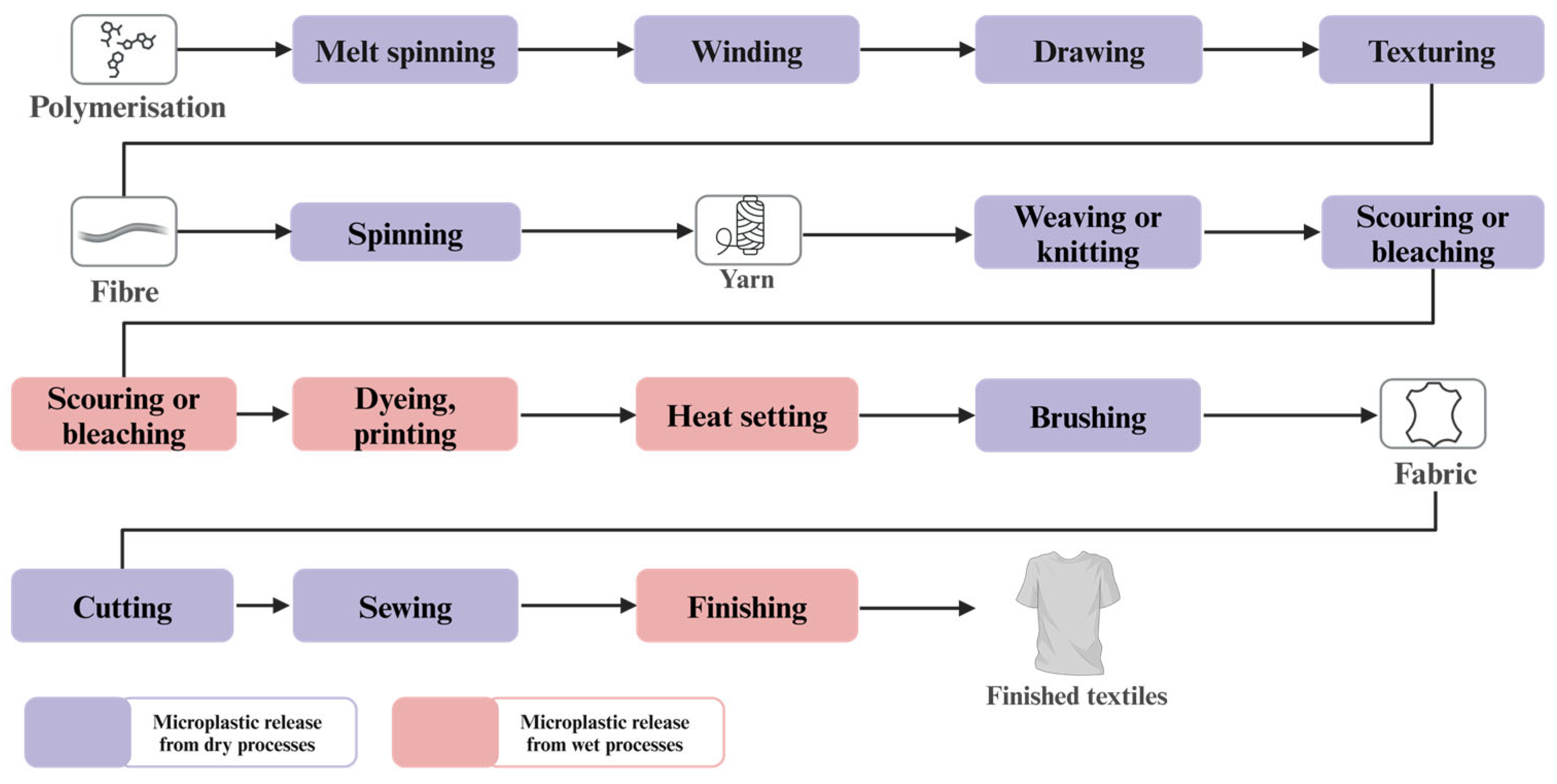
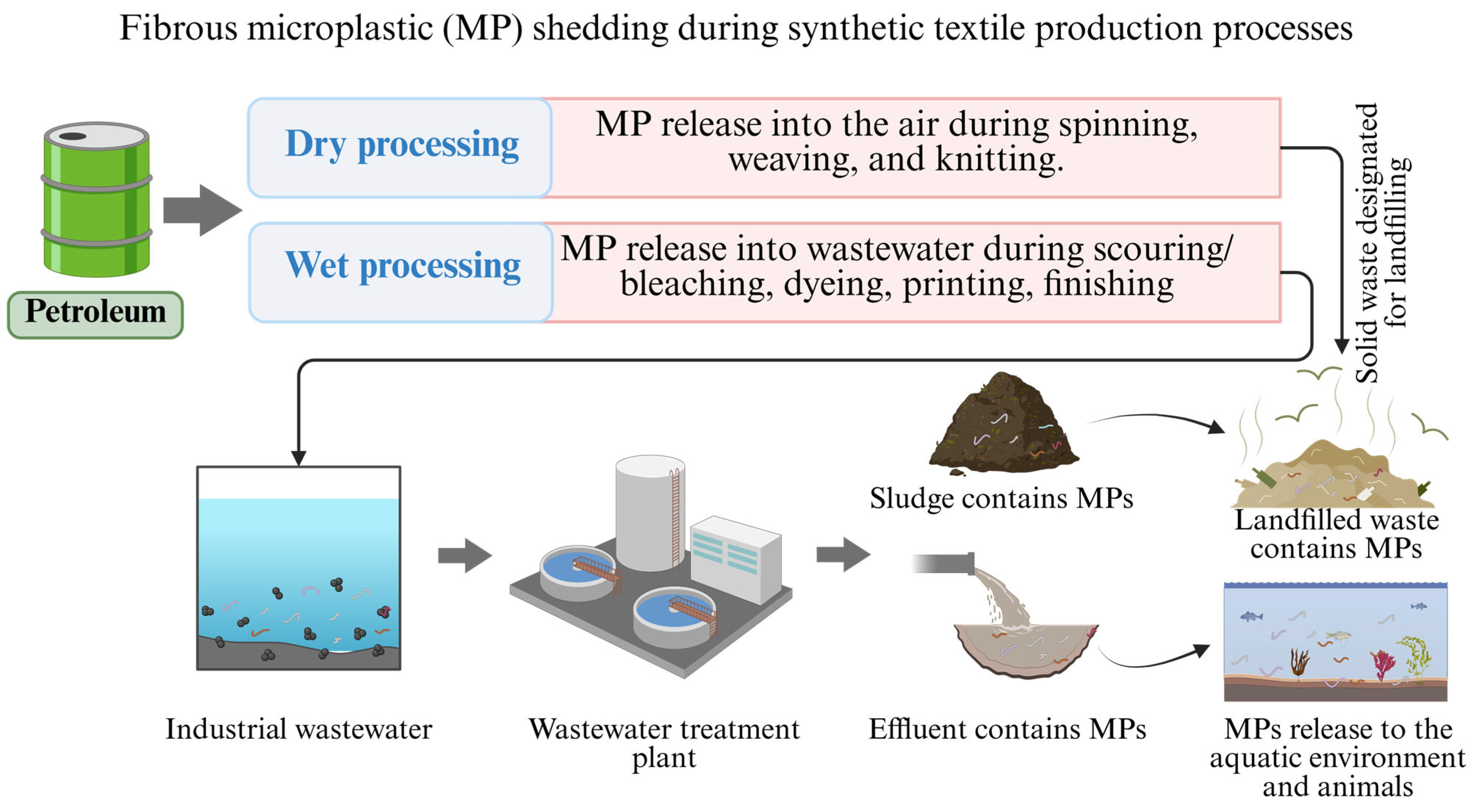
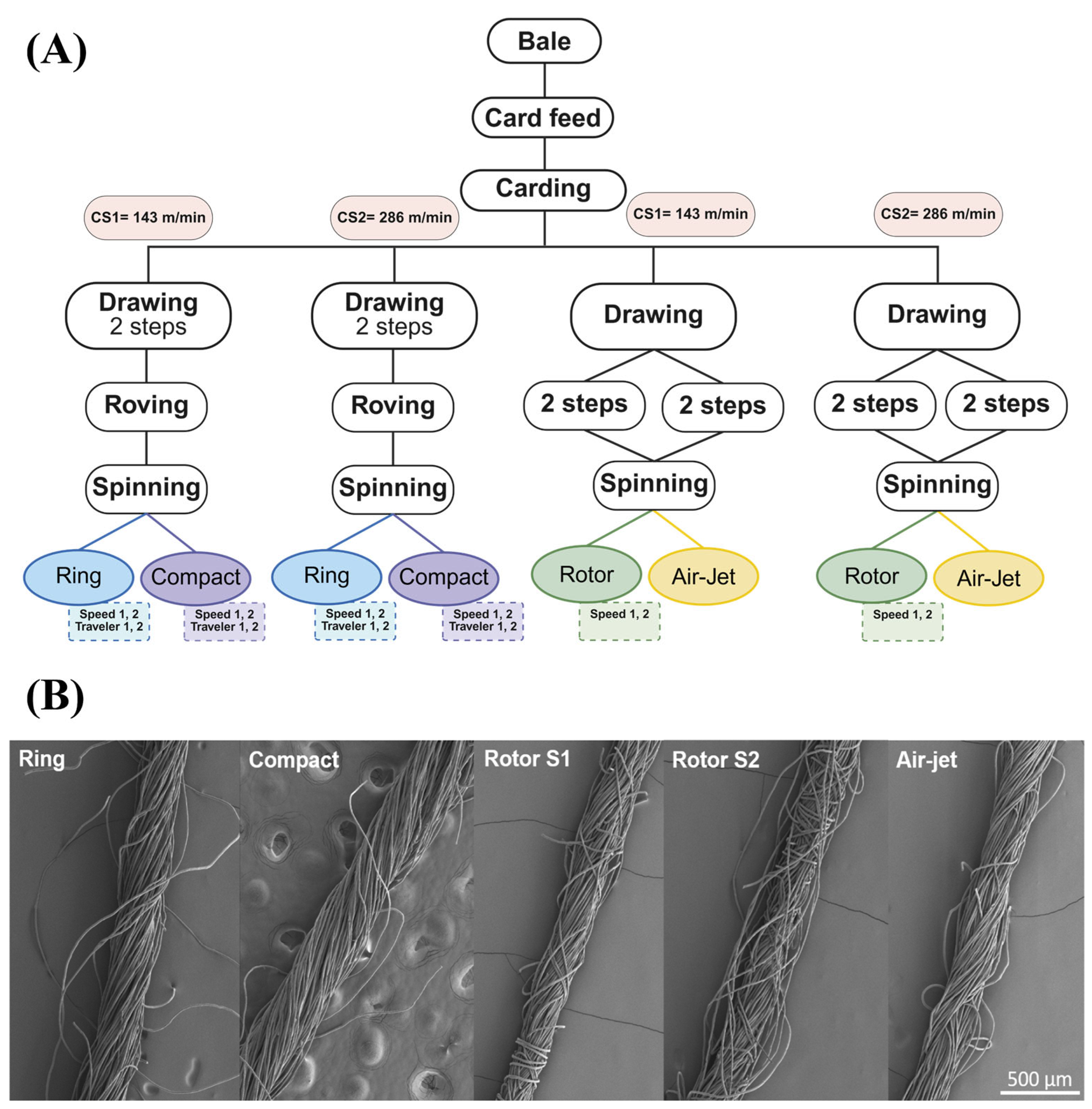
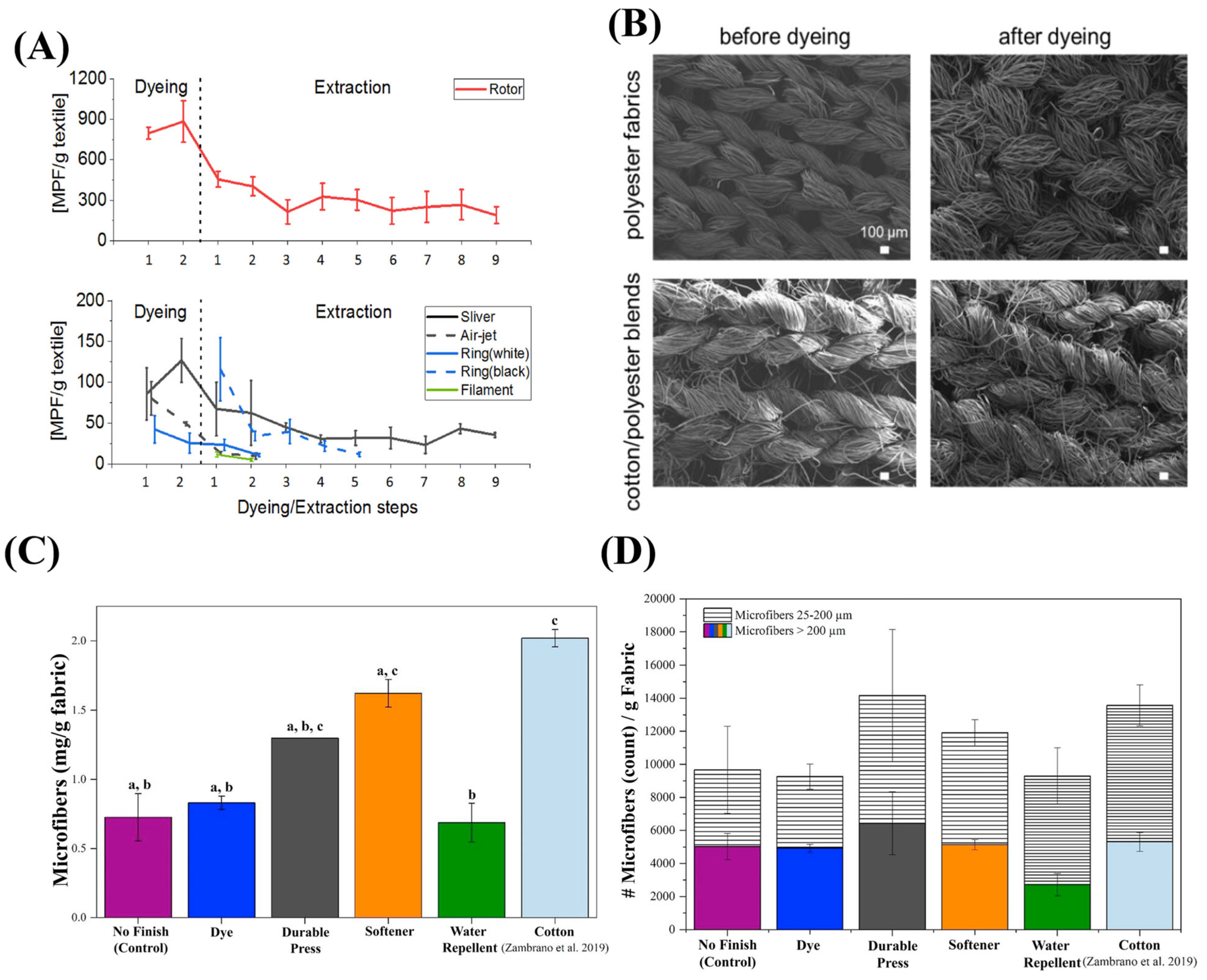
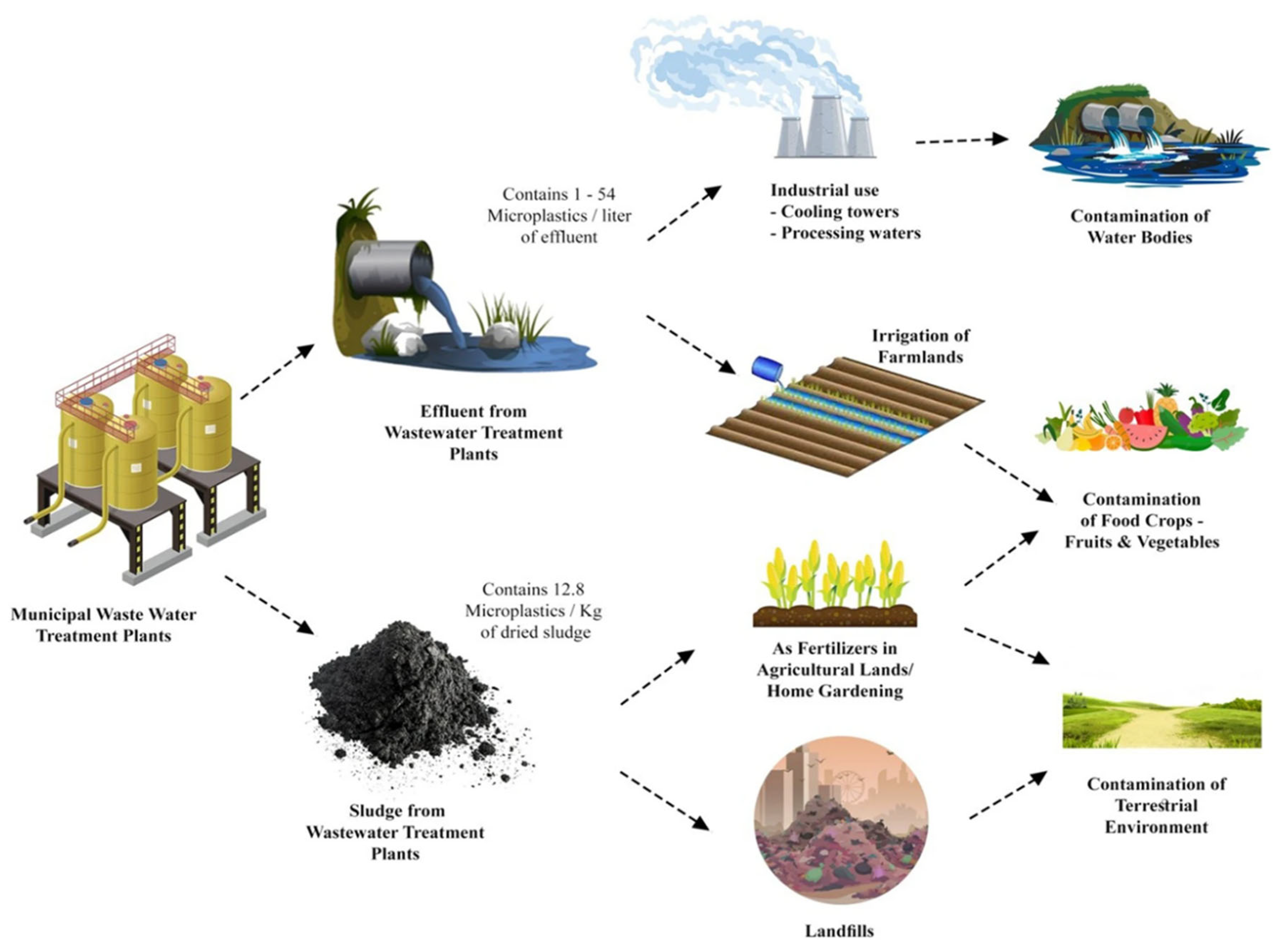
| Type of Fiber | Spinning Method | Size/Weight of the Fiber Washed | Washing Parameters [Volume; Duration; Temp.; Cycles] | Detergent | Weight of MPs [mg/kg] or Percentile Released | Average Length of MPs [µm] | References |
|---|---|---|---|---|---|---|---|
| PET staple fiber | Ring | 1.5 ± 0.1 g (1 ktex = 1 g/m, yarn) | 150 mL; 45 min; 40 °C; 3 cycles | LAS; 50 mL | 66 ± 21 | 528 ± 66 | [27] |
| Compact | 73 ± 19 | 575 ± 115 | |||||
| Rotor | 1709 ± 28 | 216 ± 1 | |||||
| Air-jet | 16 ± 2 | 328 ± 39 | |||||
| PET staple fiber | Ring | 200 × 340 mm2; folded fabric | 350 mL; 45 min; 40 °C; 5 cycles | AATCC (reference detergent) | ~940 | ~520 | [28] |
| Rotor | ~630 | ~380 | |||||
| Air-jet | ~670 | ~390 | |||||
| Flat PET | Ring | 260 × 130 mm2; folded fabric | 360 mL; 60 min; 40 °C; 5 cycles | Non-bio liquid detergent | 0.04% | - | [29] |
| Textured PET | Ring | 0.01% | - | ||||
| PET staple fiber | Ring | 0.02% | - | ||||
| PET fiber | Vortex | 290 × 150 mm2; hemmed fabric; 30 tex | 360 mL; 45 min; 40 °C; 5 cycles | Without detergent | 348.7 | - | [30] |
| Ring | 459.79 | - | |||||
| Ring | 290 × 150 mm2; hemmed fabric; 15 tex | 276.03 | - | ||||
| Vortex | 218.24 | - |
| Production Process | Sliver/Yarn/Fabric | Dye/Finish | Number of MPs Released (MPs/g) | References |
|---|---|---|---|---|
| During dyeing | Polyester sliver, 1.5 g | BEMACRON E-RD | Step 1: 86 ± 32 Step 2: 127 ± 27 | [14] |
| Polyester yarn, rotor, 1.5 g | 797 ± 45 884 ± 154 | |||
| Polyester yarn, air-jet, 1.5 g | 80 ± 20 49 ± 2 | |||
| Polyester yarn, ring, 1.5 g | 43 ± 17 26 ± 12 | |||
| Washing (AATCC standard) | Knitted cotton fabric, ring, 10 × 10 cm | C.I. reactive blue 19 | ~9700 | [8] |
| Durable press | ~14,200 | |||
| Silicon softener | ~11,900 | |||
| Water repellent | ~9300 |
Disclaimer/Publisher’s Note: The statements, opinions and data contained in all publications are solely those of the individual author(s) and contributor(s) and not of MDPI and/or the editor(s). MDPI and/or the editor(s) disclaim responsibility for any injury to people or property resulting from any ideas, methods, instructions or products referred to in the content. |
© 2025 by the authors. Licensee MDPI, Basel, Switzerland. This article is an open access article distributed under the terms and conditions of the Creative Commons Attribution (CC BY) license (https://creativecommons.org/licenses/by/4.0/).
Share and Cite
Hossain, M.I.; Zhang, Y.; Haque, A.N.M.A.; Naebe, M. Fibrous Microplastics Release from Textile Production Phases: A Brief Review of Current Challenges and Applied Research Directions. Materials 2025, 18, 2513. https://doi.org/10.3390/ma18112513
Hossain MI, Zhang Y, Haque ANMA, Naebe M. Fibrous Microplastics Release from Textile Production Phases: A Brief Review of Current Challenges and Applied Research Directions. Materials. 2025; 18(11):2513. https://doi.org/10.3390/ma18112513
Chicago/Turabian StyleHossain, Md Imran, Yi Zhang, Abu Naser Md Ahsanul Haque, and Maryam Naebe. 2025. "Fibrous Microplastics Release from Textile Production Phases: A Brief Review of Current Challenges and Applied Research Directions" Materials 18, no. 11: 2513. https://doi.org/10.3390/ma18112513
APA StyleHossain, M. I., Zhang, Y., Haque, A. N. M. A., & Naebe, M. (2025). Fibrous Microplastics Release from Textile Production Phases: A Brief Review of Current Challenges and Applied Research Directions. Materials, 18(11), 2513. https://doi.org/10.3390/ma18112513










